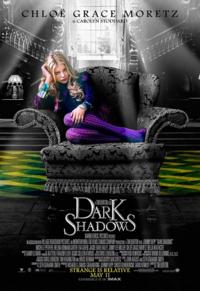Dark Shadows 2012
Warner Brothers
Director: Tim Burton
113 Minutes
MPAA: PG13
![]()
![]()
When I was young, I had a vision in my mind of a lonely, lovely woman trapped behind bars in the cellar of an ancient, crumbling castle. She had a doll that she spoke to, and sometimes she was visited by the ghost of the little girl whose doll it was. I recall feeling how sad she was, and I remember how strong my desire to help her, but in the fog of time I no longer knew that she had been imprisoned there by a vampire’s love, nor from where the image might have come into my mind.
Then, in the 1990s, I remembered. Dark Shadows was released on video, not one or two of the best episodes, but set after set of the entire run of the soap opera that ran on ABC from 1966 to 1971 (and syndicated later for children like myself to catch after school at 4pm.) It all came back to me. The Blue Whale, The crashing waves atop the theme song, Willie Loomis covering for the eccentricities of the mysterious, sad, dark man who lived back in the carriage house… the forgotten lines and boom mic dropping in from above.
Now the Dark Shadows and the wispy half-memories have returned.
Cursed to eternal life as a vampire, Barnabas Collins is then buried ‘alive’ for 200 years after spurning the advances of a beautiful servant woman, who also happens to be a witch. Waking to find the Collinwood mansion in shambles, he becomes a benefactor to the surviving Collins family, but is still stricken with despair over his lost love Josette, who jumped from Widow’s Cliff under the spell of the same witch, Angelique. Angelique, to the contrary, still harbors a spark of interest in the eternally young and attractive Barnabas, and makes an attempt to cultivate a partnership with him, since she now runs the majority of the shipping trade in Collinsport, where Barnabas’ family once reigned.
Again rejected, she sets out to destroy not only the resurrected Collins factory, but the physical reincarnation of Josette whom Barnabas has again fallen deeply in love with. The fact that Victoria, the new nanny for young David Collins, is in fact Josette reborn is hinted at early on only by David’s belief that his family is somehow trapped in an endless cycle of reincarnation. But David also has a live-in psychiatrist because of his distressed mental state. Having been traumatized by his mother’s death, he claims that he speaks with her ghost regularly. Luckily, David turns out to be more sane than his doctor, who attempts to transform herself into a vampire through transfusions of Barnabas’ blood under the pretense of trying to cure him of his sunlight-deprived state.
The movie stuck to the story for the most part, though I missed Quentin, and I was fully prepared for Tim Burton’s treatment because of the trailers and my familiarity with every other Burton film to date. I know people who swore not to ever watch the movie because they were so insulted at Barnabas’ eternal curse being reduced to a comedy, but after the revival series in the 90s, I could see clearly that the only way we would ever visit our beloved characters again would be tongue-in-cheek. And I trusted Tim Burton better than any other director to do that with the respect due to an old favorite. I was not disappointed. He painted an emotive, gothic-grey watercolor comic book as only Burton could do. He even included his signature banister railing coming to life.
It was no five star classic though; the script was simplistic and lacked the characterization that Burton obviously felt we already had, and there was a “sex scene” that was silly and superfluous.
But the soundtrack made up for it. The movie was true to the early 70s era that spawned the horror soap opera in music, costume, and culture. The Blue Whale Theme was used straight from the original series soundtrack, the rest were carefully hand-picked from the hits of the era: The Moody Blues, T-Rex, and Iggy Pop.
The movie is definitely for those above 13, as there are a few savage murders when Barnabas first re-awakens, and a plethora of innuendo and sexual humor.
Johnny Depp overacts, as usual, (but does it looking good,) making our desperate vampire act a bit like a swishy pirate.
Carolyn: …and I’m pretty sure he called me a hooker.
Josette (Bela Heathcote) resembles Uma Thurman in her early days, but her sparse performance leaves little memory of the part she played, except as a screaming banshee.
The latest horror heroine du jour, Chloë Grace Moretz, whom we have seen recently in Hugo, Let Me In, Diary of a Wimpy Kid, and Kick-Ass (and I understand a re-make of Carrie is in production with her as the vengeful outcast,) plays the teenaged Carolyn Collins. Thankfully Carolyn is a girl with taste, and she informs Barnabas that in order to present the family as again contenders of the upper class, he cannot throw a “ball,” but indeed must have a “happening,” including as Master of Ceremonies, none other than the epitome of Grand Guignol: Alice Cooper.
Alice does two full songs, not the big hits that you might expect, but surprisingly apt choices of No More Mr. Nice Guy and The Ballad of Dwight Frye. During the happening, Jonathan Frid, Lara Parker, David Selby and Kathryn Leigh Scott from the original cast all make cameo appearances as party guests.
To further accentuate the celebration of darkness that the movie is, there is a guest appearance by Christopher Lee as a ship captain. He might as easily have been cast as Joshua Collins, Barnabas’ father. Hammer’s original Dracula only gets more striking with age, his deep rasp resonating throughout the theater chilling my bones.
David’s Father Roger (Jonny Lee Miller) is presented here as greedy, ignorant scum, but it’s better than the non-character he was in the TV series.
Angelique the witch (Eva Green) is best portrayed with special effects that make her temporarily shatter like a porcelain doll. (There seems to be a lot of shattering in movies this year, much like a few years ago we saw a spate of super-fast head shaking.) The camera tends to focus on her cleavage and legs rather than her performance.
Groundskeeper Willie Loomis (Jackie Earle Haley) was cast far better in this movie than in the original series. He is given classic one-liners, and is an enjoyable part of the show.
Michelle Pfeiffer was dazzling as the Matriarch of the family, Elizabeth Stoddard Collins. Her wardrobe was stunning and her performance was a firm foundation for the storyline.
David (Gulliver McGrath) was an excellent supporting actor, and gave one of the best straight performances in the film.
And what would a Tim Burton movie be without Helena Bonham Carter (as Dr. Julia Hoffman). She was THE perfect Bellatrix LeStrange. Thankfully he didn’t try to pass her off as Angelique.
The film’s visual aspect was perfect and the costumes were to drool over, but the story left a lot to be desired, and it does fizzle out as Roger Ebert claimed; the last half is almost going through the motions to wrap up loose ends. Regardless, the movie was fun, and I will be requesting it from Netflix again and again, though I will likely not be purchasing it to own as a timeless classic.
I liked Barnabas better as a family benefactor than a tortured soul hiding away in the carriage house. I do wish I could have seen the werewolf full in full transformation, but an actress needs her face time. I also think I would rather have seen a different ending, one relying on the Collins’ cycle of reincarnation and endless despair of Barnabas, but of course, in a Tim Burton movie, the vampires must always win.
Jonathan Frid died in April 2012, just before the movie’s release, making this his final film appearance.
The original series was followed by a full-length movie called House of Dark Shadows (1970, Dan Curtis), and its sequel Night of Dark Shadows (1971). I recommend them both as late night viewing, though the latter, which did not star Jonathan Frid, is merely a gothic thriller along the lines of Dementia 13, and has little or nothing to do with the TV series.
1991 Dark Shadows – The Revival
In 1991, the TV series was re-made. They followed the same storyline as the original with new actors, none of whom seemed to be much better than the original cast. The new series did not last more than a single season, having been conceived to cash in on the Anne Rice inspired vampire craze of that era.
The Original is Still the Best
Although it may not inspire childhood memories, the old soap opera has a charm of its own. Jonathan Frid can be charming, commanding, and melancholy all at once, and what better way to watch a gothic romance soap opera filled with vampires and ghosts than in black and white? (Though the later episodes are in color.)
For best viewing, don’t get the “Scariest Moments” video or the “Best of” series from MPI home video. (I say that though I myself own them, and they are great for when you don’t really want to sit down with a bowl of popcorn, but they don’t have the strength to pull you into a story or allow you to bond with the characters.) This show was meant to be watched in serial format. So pick an era, whether it’s the very first shows, the introduction of Barnabas, the haunting of Quentin, or the flashback to the witch hunts with Reverend Trask, and watch as much as you can in one sitting. Recognize that the production values of a daily TV soap in the 1960s lacked finesse, suspend your disbelief, and go for the ride.
Then there are the books. In the 1970s a 32 volume series of paperback romance novels based on the TV show were published, including… –yes,– a cookbook written by a vampire.
Dark Shadows Paperback Library






